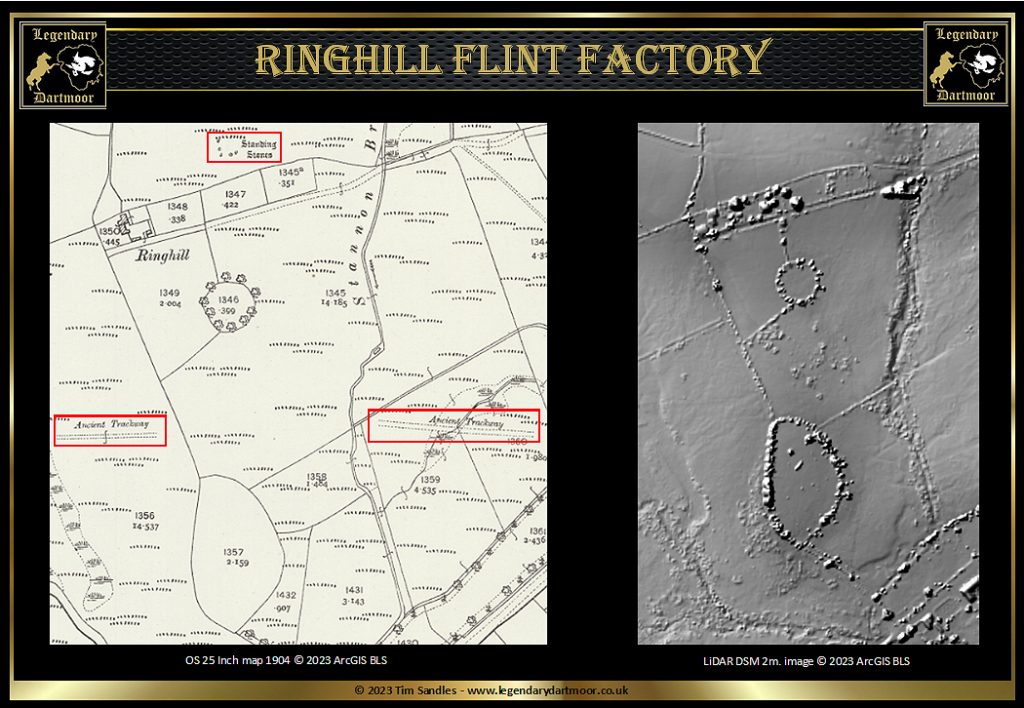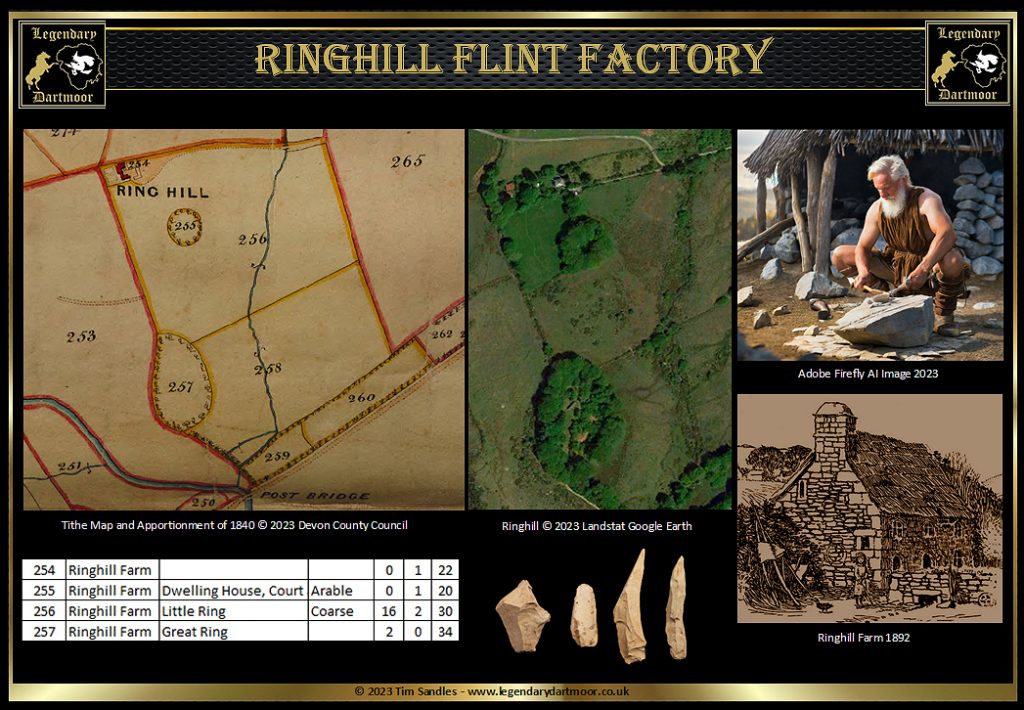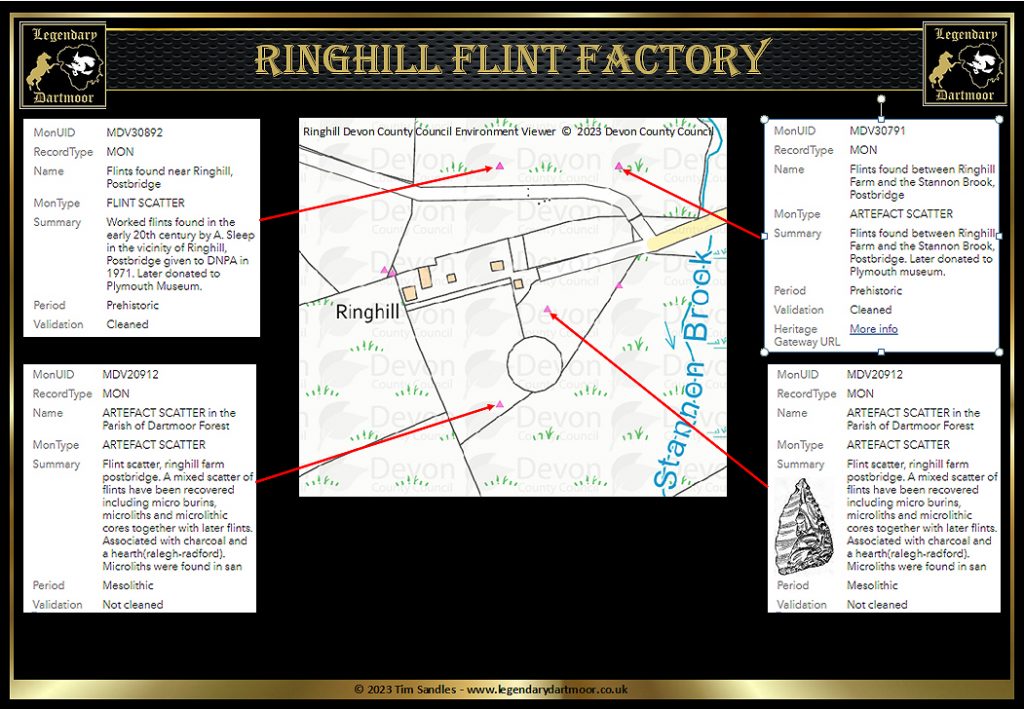
There are two locations on Dartmoor where the placename “Ringhill” can be found. The first is just to the east of Oxenham Manor where there is the “Ringhill,” “Ringhill Coppice” and “Ringhill Cross.” The second lies just to the north of Postbridge in the form of what was once “Ringhill Farm” along with “Ringhill Newtake”.
The Place-Name Society give no explanation to the etymology of the name but in the case of the Postbridge Ringhill other sources allude to the small circular ring of trees which can be found there. Whilst doing an online search for this I can across the following, in 2018 Ringhill was for sale. As part of the particulars it boasted the fact that on the property was “a fascinating large circle of beech trees set in what is believed to be a prehistoric stone enclosure – the reason for the property’s name.” In his book “Dartmoor Idylls” of 1896 Sabine Baring Gould wrote about Ringhill “It is in fact, an old walled village that has had the huts within the wall destroyed. The stones from the primaeval bee-hive habitations have been removed and utilised for the construction of a quaint little farmstead, enclosed within rectangular walls to screen its windows and door from the hurricane and snow and hail.” p.142. As the wooded circular enclosure only measures 48 metres at its widest point it is very unlikely there was enough room inside it for more than one hut. In the Lydford Forest tithe map and apportionment of 1840 there are two plots shown called “Great Ring” (257) and “Little Ring” (255). The “Little Ring” which is the small circular wooded enclosure mentioned in the above description (see on the map below). Oddly enough this is listed in the apportionment as being the “dwelling house, court, and garden” which surely is a mistake and should be recorded as “Little Ring”? It is not unheard of for prehistoric monuments such as cairns or small pounds etc to be enclosed by later circular walls and/or trees such as this one. The precise reason for this is unsure, possibly to preserve and protect what lies within from livestock etc. or maybe of some relic sacred belief or superstition. In his ‘Dartmoor Field Guides’ Mike Brown mentions “On the east side of the marshes is Ring Hill, Ringhill Copse standing within the small enclosure on its summit.” -Vol. 37, p. This is the only reference to the wooded enclosure being named as “Ringhill Copse” that I can find.
Further delving revealed an interesting comment in the Transactions of the Devonshire Association (TDA) of 1866. Robert Burnard wrote “A well worked knife or lancehead, which has been broken across the flaking which was found this spring at Ring Hill, Postbridge.”p.91. His drawing of this artefact can be seen below. Twenty-five years later Mr. A. B. Prowse wrote about Ringhill in the TDA of 1891 – “… is a nearly circular field fifty yards across, and also girt by trees. I am not satisfied that there any undoubted traces of the ancient ring-fence or of hut circles; but considering its shape, position, and surroundings I have no doubt whatever that its site is that of an ancient pound. The name of the little farmstead close by – Ringhill – was probably suggested by its proximity.” T.D.A, The Ancient Metropolis of Dartmoor, p.309.
The title of this paper “The Ancient Metropolis of Dartmoor” is in itself interesting as it refers to the large number of prehistoric features that can be found in and around the area. As part of these the Devon County Environment Viewer map of Ringhill shows four areas where scatters of flint artefacts have been identified –
The first being the assemblage to the North of the farmstead (MDV30892) was found by Silas Sleep who was farming Ringhill in the early 1900s. Eric Hemery in his High Dartmoor book mentions how Robert Burnard would reward the young girl Annie Sleep with a sixpenny piece for every piece of flint she found. p.544. Completely off topic but Silas Sleep also worked at the nearby Powder Mills gunpowder factory. He was well known for eating his lunch as soon as he turned up for his shift. This was to make sure if he was killed in an explosion at least he had eaten his meal.
The second just to the east of this one (MDV30791), both flint finds were donated to the Plymouth Museum.
The third, a much larger and varied flint scatter was found along with later flint cores. (MDV 20912) just to the south of the farmstead. Regarding this particular assemblage J. W. Brailsford wrote in his 1938 Bronze Age Monuments of Dartmoor – “A Miss Barbara Shaw discovered a microlithic assemblage at Ringhill along with some charcoal and a hearth in an occupational layer. Present were micro-burins, microliths, and cores suggestive of a microlith industry. It has been suggested that these artefact date back prior to the late neolithic age.” p.460. This assemblage was donated to the Exeter Museum with other possible finds from the chipping floor to Torquay Museum. However, the Devon and Dartmoor HER record claims that these finds were made by Mr. W. G. Wallace in 1934.
The fourth findspot (MDV15710) was the knife or lancehead found by Robert Burnard as noted above.
In the case of the third findspot is the first suggestion that the area around Ringhill was possibly an early example of ‘Prehistoric Industrial’ activity. But apart from a single flint arrowhead found in Greyhound Marsh just below the farm all evidence of flint making comes from in and around the immediate enclosures of Ringhill. Does this mean that this was a dedicated site where the flint nappers worked or even possibly lived? It also must be remembered that flint does not naturally occur on Dartmoor and so these finds came from imported flint cores. This in itself must allude to some kind of trading taking place between Dartmoor and the source of the flint.
With regards to Prowse’s term “Ancient Metropolis of Dartmoor,” one only has to look around the nearby landscape to see how he came to this conclusion. As can be seen on the OS map above just above Ringhill there are some standing stones or what today is termed as a stone alignment. These are described as being of a “weathered appearance, suggestive of great antiquity.” It is thought that originally there were five stones but by 1951 one of them had vanished, possibly in the building of the track to nearby Hartyland and the other two were recumbent. The big question being from whence did they originate? Half a mile SSW of Ringland is the enclosed pound at Archerton Camp followed by ‘The Roundy Pound” settlement half a mile to the NW with all the hut circles, cairns, cists, and reaves inbetween on Chittaford Down with similar features further on below Broadun. Further to the south is the wide stretching Bellever ritual complex with even more evidence of prehistoric settlement and land use.
But back to the original line of enquiry, namely what supposed prehistoric feature lies withing the ‘ring’ of trees? In the TDA of 1903 the Twenty Second Report of the Barrow Committee stated that “There are two tumps in the ring shaped enclosure at Ringhill, Postbridge. They were dug into, and they were found to be small mounds covering some large stones which were partly filling wide and deep pits which had been sunk from 2 to 3 feet into the “calm.” They did not appear to be the remains of graves, but rather of pits in which menhirs might have stood, and the stones found in them were used as triggers. These mounds are in a straight line with the standing stones in Hartland Newtake, which are distant about 100 yards.” pp.141-2. These remarks would clearly concern the stone alignment noted above. However, one slight issue, menhirs are normally found on their own, never in pairs so that would rule this idea out. Alternatively if the stone alignment ran through Ringhill farm from the circle to the hillside above and the missing stones in the row were taken for ‘recycling’ this would also rule out a stone row. The only other suggestion that I can find comes from Eric Hemery when in his opinion there is a “central cairn” inside the circle – High Dartmoor, p.544. Unfortunately there seems to be no credible modern archaeological excavation of the ‘Ring’ and so its contents can add to the huge list of Dartmoor mysteries.
Just before you go here is one last thing about Ringhill. The black and white sketch above of what appears to be a ramshackle cott was drawn in 1892 and is fact the old dwelling at Ringhill. Its claim to fame is that the ‘Dartmoor Poet’ Jonas Coaker lived here as a boarder during the last years of his life, he died in 1890.
 Legendary Dartmoor The many aspects past and present of Dartmoor
Legendary Dartmoor The many aspects past and present of Dartmoor



